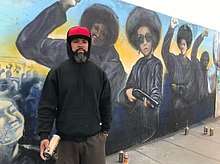Destination Crenshaw
Destination Crenshaw is an under-construction 1.3-mile-long (2.1 km) open-air museum in Los Angeles, California, dedicated to preserving the history and culture of African Americans.[2] The museum stretches along Crenshaw Boulevard, enhancing the public structures and business facades with landscaping and public art by adding pocket parks, gathering points, overlooks, murals, sculptures and texts.[3]

| |
| Established | 2019 |
|---|---|
| Location | Crenshaw Boulevard, Hyde Park, Los Angeles |
| Coordinates | 34°0′0″N 118°19′51″W |
| Type | History and culture of African Americans |
| Architect | Zena Howard, (Gabrielle Bullock, managing principal) Perkins+Will[1] |
| Website | Official website |
Elements

The museum will have 100 permanent and temporary public artworks.[4] The southern end of the project, near Slauson Avenue, will have the Gateway Monument, a 120-foot-tall (6.1 m) totem that spells out Crenshaw in giant letters. At the northern end of the project adjacent to the Leimert Park Metro station will be Sankofa Park.[5] The node called Dreams at 50th Street is inspired by local architect Paul Revere Williams (1894 – 1980).[6] An existing mural, "Our Mighty Contribution", will be restored, protected, and lit.[7]
Formation
The major commercial corridor for the Hyde Park, Leimert Park and Baldwin Hills/Crenshaw neighborhoods is known as "the heart of African American commerce in Los Angeles".[8][9][10] The project was conceived to celebrate the Crenshaw business district as a black community amid fears of gentrification with the arrival of the Crenshaw/LAX light rail line and the NFL Stadium in Inglewood.[4] In the midst of the transit construction and coming demographic changes, this placekeeping project celebrates being “unapologetically, authentically black.”[11] Like Koreatown, Chinatown and Olvera Street, proponents want this project to provide an identity to this community and highlight the historic nature of South Los Angeles.[4]
Business owners and residents were upset that the light rail trains running at street level would remove parking spaces essential to the commercial area.[5] The train tracks could also be a barrier that further impacts local small businesses.[1] As the light rail line brings the possibility of gentrification, efforts are being made to ensure the project benefits the people who already live along the route.[11] The project has worked to support local businesses by providing infrastructure improvement grants for business owners who own their properties, including code compliance work, new parking spaces, building repairs and culturally stamped sidewalks.[12] Contractors will be required to hire workers who are underrepresented minorities in the trades.[13] Local artists have also been sought for the project.[11]
The office of Los Angeles Council member Marqueece Harris-Dawson has engaged the neighborhood in the project.[14] He brought together leaders from South Los Angeles including artists, activists, curators, filmmakers, community organizers, and musicians. The stakeholders and experts included Judith Baca, Ben Caldwell, Ron Finley, Mark Steven Greenfield, and Nipsey Hussle before his death in March 2019.[3] Issa Rae spoke at the groundbreaking ceremony at the end of Black History Month on February 29, 2020.[2][15][16]
See also
- Lists:
- History of the African Americans in Los Angeles
- African Americans in California
References
- Olson, Carly (February 20, 2020). "How Perkins and Will's Gabrielle Bullock Built a Career Empowering People of Color". Architectural Digest. Retrieved February 28, 2020.
- Barragan, Bianca (February 21, 2020). "11 developments sprouting along the Crenshaw Line, mapped". Curbed LA. Retrieved February 23, 2020.
- Dambrot, Shana Nys (November 14, 2018). "Destination Crenshaw: Black Los Angeles Greets the World". LA Weekly. Retrieved February 17, 2020.
- Chiotakis, Steve (March 2, 2020). "Destination Crenshaw breaks ground. LA residents are excited but fear gentrification". KCRW. Retrieved March 18, 2020.
- Davidson, Justin (February 17, 2020). "L.A.'s Beguiling Idea: An African-American Arts Destination". Intelligencer. New York Magazine. Retrieved February 28, 2020.
- Hickman, Matt (May 1, 2020). "Destination Crenshaw celebrates the culture of South Los Angeles as it parades down the community's main drag". The Architect's Newspaper. Retrieved May 3, 2020.
- Shaw, Anny (February 16, 2019). "Wearing its art on its sleeve: Los Angeles' enduring passion for murals". The Art Newspaper. Retrieved August 10, 2020.
As part of the $100m project, Our Mighty Contribution is due to be fully restored and treated with a protective coating.
- Robinson-Jacobs, Karen (May 2, 2001). "Noticing a Latin Flavor in Crenshaw". Los Angeles Times. Retrieved January 21, 2016.
- Meares, Hadley (May 17, 2019). "How Crenshaw became black LA's main street". Curbed LA. Retrieved May 18, 2019.
- Parra, Alvaro (October 23, 2014). "Crenshaw Boulevard: Cruising Through the Decades". KCET. Retrieved May 3, 2020.
- Easter, Makeda (January 30, 2019). "Destination Crenshaw art project aims to reclaim the neighborhood for black L.A." Los Angeles Times. Retrieved February 29, 2020.
- "Destination Crenshaw Supports Legacy Businesses". Los Angeles Sentinel. February 6, 2020. Retrieved February 17, 2020.
- "Destination Crenshaw's Pipeline to Public Sector Jobs". Los Angeles Sentinel. February 21, 2020. Retrieved February 28, 2020.
- Sulaiman, Sahra (February 9, 2019). "Destination Crenshaw and the Rise of We-Built-this-Place-Making". Streetsblog Los Angeles. Retrieved February 25, 2020.
- Love, Marianne (February 27, 2020). "Groundbreaking for Destination Crenshaw will set new era in motion for LA neighborhood". Daily News. Retrieved February 28, 2020.
- Samaha, Barry (July 23, 2020). "Issa Rae's Style Continues to Get Brighter and Bolder". Harper's BAZAAR. Retrieved August 10, 2020.